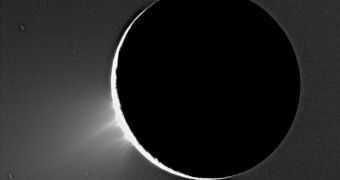In the outcome of previous observations showing that Saturn's moon Enceladus ejects matter out of the geysers on its surface, the Cassini spacecraft executed, on Wednesday, a fly-by through the water ice plume hovering above it. During the swing, Cassini took numerous pictures of the surface of the moon and made several measurements related to it characteristics, such as composition, density, speed, size and others.
Although the icy plume extends on 200 kilometers into space, NASA's Jet Propulsion Laboratory decided to make a fly-by at an altitude of only 50 kilometers above the surface of Enceladus, once engineers established that the debris does not present any danger for the correct operation of the orbiter. Speeding through the plume at a velocity of 51,200 kilometers per hour, Cassini conducted several measurements hoping to determine whether there is a water ocean under the icy surface, or any organic molecules inside the moon.
Fractures within its surface areas located near the south pole of Enceladus eject water vapors into space, which eventually freeze into small particles of ice that raise high above the moon, to be later collected by Saturn's powerful magnetic field and transported towards the rings.
The latest pictures taken by Cassini reveals that the northern polar region, scattered with craters, is much older than the southern hemisphere. Carolyn Porco, Cassini imaging scientist said that the new images provide with a comparison for the future study of the complex geological history of Enceladus. Porco, who is also a scientific consultant and researcher of the Space Science Institute, adds that this was only the first step in understanding the dynamics of the plume, the next investigation will require a much lower altitude fly-by and will most likely take place somewhere in the course of this summer.
Cassini suffered an instrument failure, namely the Cosmic Dust Analyzer, during its latest fly-by. It seems that the problem is software related, preventing it from analyzing the sample. Nonetheless, the problem was fixed in the second part of the fly-by and was able to collect data during the departure phase. Porco says that all instrumentation is now working within normal parameters.

 14 DAY TRIAL //
14 DAY TRIAL //